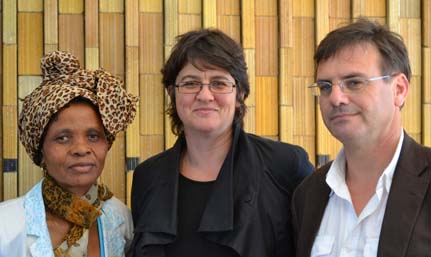Dialogue between Science and Society series looks at forgiveness and reconciliation
|
 |
Taking part in the discussion on forgiveness and living reconciliation, were from left: Olga Macingwane, a survivor of the Worcester bombing of 1993; Dr Juliet Rogers, a Scholar on Remorse from the University of Melbourne in Australia and Dr Deon Snyman, Chairperson of the Worcester Hope and Reconciliation Process.
Photo: Mandi Bezuidenhout
24 March 2013 |
How do you, as a mother who lost her only daughter, forgive the man who claimed responsibility for the attack that killed her? How do you forget his crime while travelling with him across the world?
These were some of the questions posed to Jeanette Fourie at a Dialogue between Science and Society series on forgiveness and living reconciliation. Jeanette, whose daughter Lyndi was killed in an attack on the Heidelberg Pub in Cape Town in 1993, was one of three people telling their stories of forgiveness while dealing with traumatic experiences.
Sitting next to Letlapa Mphahlele, the man who owned up to the attack that killed her daughter, Jeanette spoke about their story of forgiveness traveling the world together, spreading the message of forgiveness and conciliation.
"Don't ever think you can forget, because that’s not possible. What you do with the pain is to find peace, and that's what forgiveness does. Forgiveness allows you to stop all the dialogue in your head on why he did it. You don't forget, you confront it and you deal with it."
Letlapa, Director of Operations of Apla, the military wing of the PAC at the time of Lyndi's death, spoke about dealing with the response to his crime. "Sometimes you wish that you were not forgiven, because now you have the great burden of proving that you are worthy of forgiveness."
Also telling her story of forgiveness was Olga Macingwane, a survivor of the Worcester bombing of 1993 in which four people were killed and sixty-seven others injured. Four people were sent to prison. In 2009 Olga met one of the perpetrators, Stefaans Coetzee, and what came out of that meeting, is her story.
"When I met Stefaans I was very angry, but when you sit down with somebody and listen to him or her, you find out what the reasons were that made him or her do something. I can say that I forgave him."
Facilitating the conversation, Prof Pumla Gobodo-Madikizela, Senior Research Professor on Trauma, Forgiveness and Reconciliation, said the seminar was meant to get in touch with the truth that forgiveness is possible.
"Before we had the Truth and Reconciliation Commission (TRC) in South Africa, the experts always said that forgiveness was not possible in these stories of the past. And then the TRC came into life as a response to mass atrocities. For the first time in the history of these traumatic experiences, of political traumas, we witness something that we have never seen. Even us on the TRC, although it was framed as reconciliation, we never imagined there would actually be stories of forgiveness emerging out of that process, and then we witness that this too is possible."
Others who took part in the two-hour-long seminar, were Dr Juliet Rogers, a Scholar on Remorse from the University of Melbourne in Australia and Dr Deon Snyman, Chairperson of the Worcester Hope and Reconciliation Process. They spoke about the dynamics behind the processes of engagement between victims/ survivors and perpetrators.
The Dialogue between Science and Society series was co-hosted by the Institute for Reconciliation and Social Justice.